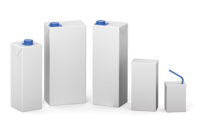Effective and Efficient Packaging Solutions
Recent developments in sustainable packaging technology can provide many benefits.

Over the years, advancements in technology and efficient production processes have significantly improved sustainable packaging in the adhesive and sealant markets. As sustainable packaging technology has developed, so has the overall way in which it is used. The advancements in adhesive and sealant packaging help promote sustainability, decrease overall waste, create a more efficient process and generate cost savings-all while enhancing the overall product value.
In order to extend the life of the material, manufacturers should instead consider a screw-on nozzle. This type of nozzle can be switched in between cartridges to save leftover material. It is a subtle option that not only extends value and efficiency to customers but also helps to conserve cost and waste.

Over the years, a new process has been developed for squeeze tube manufacturing that eliminates the aluminum packaging. This new method extends the life of the product and eliminates the need for costly blister card and plastic packaging. Instead of using aluminum, manufacturers have implemented the use of laminate squeeze tubes that are more cosmetically appealing and offer a more durable form of packaging to prevent waste. The laminate squeeze tube is more environmentally friendly than the aluminum tube and can easily be disposed of and recycled. The blister cards and plastic packaging have also been reformed by the creation of a wider seal and a variety of custom retail shelf hang hole punches at the top of the tube.
Some manufacturers have also added nitrogen to the filling process to prolong product life. The nitrogen removes oxygen to extend the life of the material and eliminate overall waste. These solutions only begin to explore the domain of more highly efficient packaging forms. The new squeeze tube technology has eliminated 30% of the waste associated with the traditional aluminum squeeze tube manufacturing. The life of the product has been extended through a nitrogen fill system, which then eliminates unused cured material in landfills. All these improvements help to conserve time, cost and waste-and add efficiency.
The benefits to the sausage pack become readily apparent when compared to a caulking cartridge. When a caulking cartridge is empty, it creates a lot of waste due to its surface area. When the chub is being dispensed, it can be folded to decrease the amount of surface area-related waste by over 90%. The film used by the sausage pack is also considerably lighter than the plastic caulking cartridge. Because it is such a precise form of sustainable packaging, the sausage pack has long been considered a green alternative and is becoming increasingly prevalent in the industry.

Pouches have a lot of the same advantages as sausage packs. The design allows for a pouch to be used without a nozzle, which greatly decreases waste. In addition, no dispensing gun or applicator is needed, and the pouch helps reduce waste in small applications where only a small amount of product is required. The pouch also allows for more space in assembly kits and decreases the amount of waste associated with the kits. The pouch is durable and will not dent and puncture as easily as an aluminum squeeze tube. The amount of waste associated with the film is significantly less than the squeeze tube because of these added benefits. Thus, the pouch is a user-friendly form of sustainable packaging.
For more information, contact American Sealants Inc. at 3806 Option Pass, Fort Wayne, IN 46818; phone (800) 325-7040; email asiinquiry@gmail.com or azaremba@americansealantsinc.com; or visit www.americansealantsinc.com.

Over the years, advancements in technology and efficient production processes have significantly improved sustainable packaging in the adhesive and sealant markets. As sustainable packaging technology has developed, so has the overall way in which it is used. The advancements in adhesive and sealant packaging help promote sustainability, decrease overall waste, create a more efficient process and generate cost savings-all while enhancing the overall product value.
Simple Solutions
The differences in most standard forms of packaging are subtle yet significant. For example, the standard 10.2-oz caulking cartridge uses a nozzle and dispensing method that can significantly affect the amount of waste. With a fixed nozzle cartridge system, the material can cure in the nozzle between uses, causing the cartridge to be unusable and leading to a significant amount of wasted material. Material that cannot be dispensed may also be left in the nozzle after use.In order to extend the life of the material, manufacturers should instead consider a screw-on nozzle. This type of nozzle can be switched in between cartridges to save leftover material. It is a subtle option that not only extends value and efficiency to customers but also helps to conserve cost and waste.

A new process has been developed for squeeze tube manufacturing that eliminates the aluminum packaging.
Evolution of the Squeeze Tube
Guided by the retail-oriented section of the market and consumers who demand ease of use, the squeeze tube has been used in silicone, sealant and adhesive packaging applications for the past few decades. Aluminum squeeze tubes have been the market standard and are often sold in a blister card pack that incorporates plastic and cardboard. This form of packaging produces a significant amount of waste, due to the plastic and cardboard components. Aluminum packaging is also subject to cracks and dents that can create holes in the product and lead to more overall waste.Over the years, a new process has been developed for squeeze tube manufacturing that eliminates the aluminum packaging. This new method extends the life of the product and eliminates the need for costly blister card and plastic packaging. Instead of using aluminum, manufacturers have implemented the use of laminate squeeze tubes that are more cosmetically appealing and offer a more durable form of packaging to prevent waste. The laminate squeeze tube is more environmentally friendly than the aluminum tube and can easily be disposed of and recycled. The blister cards and plastic packaging have also been reformed by the creation of a wider seal and a variety of custom retail shelf hang hole punches at the top of the tube.
Some manufacturers have also added nitrogen to the filling process to prolong product life. The nitrogen removes oxygen to extend the life of the material and eliminate overall waste. These solutions only begin to explore the domain of more highly efficient packaging forms. The new squeeze tube technology has eliminated 30% of the waste associated with the traditional aluminum squeeze tube manufacturing. The life of the product has been extended through a nitrogen fill system, which then eliminates unused cured material in landfills. All these improvements help to conserve time, cost and waste-and add efficiency.
Environmentally Friendly Sausage
The persistent struggle to find a form of sustainable packaging that is cost efficient and practical has always been prevalent in the adhesive and sealant industry. A form of packaging is often required to be both large enough for higher volume applications and flexible enough to move around job sites, sometimes in less-than-ideal conditions. Such applications may have factors that can affect the necessary form of packaging, such as waste restrictions or a limited amount of space. The sausage pack, however, is ideal for these types of applications. The sausage pack (otherwise known as the chub) comes in a film roll that is dispensed with a gun similar to a caulk gun. Sausage packs are available in different sizes to aid in increasing productivity.The benefits to the sausage pack become readily apparent when compared to a caulking cartridge. When a caulking cartridge is empty, it creates a lot of waste due to its surface area. When the chub is being dispensed, it can be folded to decrease the amount of surface area-related waste by over 90%. The film used by the sausage pack is also considerably lighter than the plastic caulking cartridge. Because it is such a precise form of sustainable packaging, the sausage pack has long been considered a green alternative and is becoming increasingly prevalent in the industry.

Pouches can be used without a nozzle, which greatly decreases waste.
Portable Pouches
Some sustainable packaging needs to be both efficient (like the sausage pack) and small enough for kits and other tiny applications. This demand in the market has led the way for pouch packaging. The pouch holds approximately ½ oz of material and is made out of a film material similar to that of the chub. It has a built-in, tear-off nozzle that allows for easy dispensing. Detailed labeling work can also be printed onto it easily. The pouch can hold a variety of materials and is moisture resistant.Pouches have a lot of the same advantages as sausage packs. The design allows for a pouch to be used without a nozzle, which greatly decreases waste. In addition, no dispensing gun or applicator is needed, and the pouch helps reduce waste in small applications where only a small amount of product is required. The pouch also allows for more space in assembly kits and decreases the amount of waste associated with the kits. The pouch is durable and will not dent and puncture as easily as an aluminum squeeze tube. The amount of waste associated with the film is significantly less than the squeeze tube because of these added benefits. Thus, the pouch is a user-friendly form of sustainable packaging.
Making Changes
Packaging in the adhesive and sealant markets continues to evolve. While the world is becoming more environmentally aware, efficiency and cost remain important concerns. Becoming more informed about a product development or converting to a new form of packaging can make a significant difference for many manufacturers. Due to the latest packaging advancements, cost-efficient, environmentally friendly, and practical solutions are readily available.For more information, contact American Sealants Inc. at 3806 Option Pass, Fort Wayne, IN 46818; phone (800) 325-7040; email asiinquiry@gmail.com or azaremba@americansealantsinc.com; or visit www.americansealantsinc.com.
Links
Looking for a reprint of this article?
From high-res PDFs to custom plaques, order your copy today!





